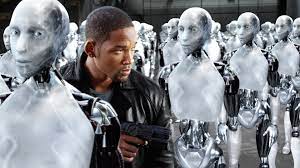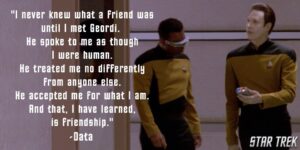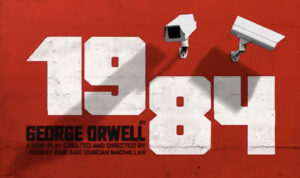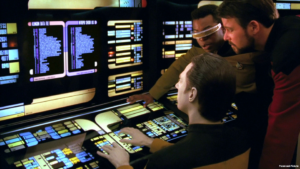How Sci-Fi Visionaries Shaped Our World Today
Part 3 in our series How Storytelling Shapes Our Future [You can find Part 1: Crafting Tomorrow: The Prophecies of the Past and Part #2 Artists and Experts in Shaping Tomorrow]
“Science fiction is the history of ideas, the history of our civilization birthing itself,”
— Ray Bradbury, Zen in the Art of Writing
This powerful quote reminds us of the power of the transformative potential of imaginative creation. As we saw in our previous post, art in its myriad forms, complements this birthing process, acting as a guiding force for generations of visionaries.
These artistic movements have influenced generations of visionaries who melded their creativity with societal insights and their distinct contributions not only acted as inspiration for our societal vision but actively influenced them.
Let’s take a deeper dive into the imagination and knowledge of the visionaries and thought leaders who were influenced by the intersection of art and science that we have explored and how they have contributed to our world today and who continue to influence our future.
Isaac Asimov: Pioneering AI Challenges and Ethics

Isaac Asimov’s Three Laws of Robotics has pervaded science fiction and is referred to in many books, films, and other media. They have also influenced thoughts on the ethics of artificial intelligence.
Isaac Asimov, a celebrated author and biochemist, profoundly impacted not only science fiction but also our conceptual and practical approach towards technology, particularly in the fields of robotics and artificial intelligence. His foresight into the potential coexistence of humans and machines formulated the renowned Three Laws of Robotics, a set of ethical guidelines introduced in his 1942 short story “Runaround” which aimed to ensure the safety of humans interacting with robots.
These laws dictated that a robot must:
- Not harm a human,
- Obey orders from humans unless they conflict with the first law, and,
- Protect its own existence unless it violates the first or second law.
Asimov’s Three Laws of Robotics and Their Real-world Impact
Notably, researchers at MIT’s Computer Science and Artificial Intelligence Laboratory (CSAIL) and leading tech companies like Google and OpenAI have referred to Asimov’s laws when framing their approach to AI safety and guidelines. In fact, these laws have become a pivotal conceptual framework for engineers and ethicists, shaping dialogues and approaches toward developing autonomous machines that prioritize human safety and ethical interaction.
Moreover, Asimov’s vast array of works, including notable pieces like “I, Robot” and “Foundation”, did not merely posit technological theories but explored the sociological and philosophical ramifications of advanced technologies. He deftly crafted narratives that questioned the roles, responsibilities, and ethical conundrums faced by humanity in technological landscapes. His speculative fiction doesn’t just explore machines and technologies; it delves into future societies shaped by these technologies, laying the groundwork for our discussions today about the social, ethical, and political implications of AI and robotics.
Asimov also contributed significantly to the concept of machines aiding problem-solving and decision-making processes in fields like mathematics, logistics, and scientific prediction.

“I never knew what a friend was until I met Geordi. He spoke to me as though I were human. He treated me no differently from anyone else. He accepted me for what I am. And that I have learned is friendship.” Data, Star Trek: The Next Generation, 5×24
The notion of positronic brains, introduced in his robot series, and explored later in the Star Trek series through the character “Data”, endowed robots with a form of synthetic consciousness, sowed seeds for imagining machines that could potentially think, learn, and evolve autonomously. Data in the Star Trek series, whose vast knowledge set him apart from his human counterparts, often wrestled with his own quasi-humanity and the implications of being a robot. This is the very issue that Asimov wanted humans to imagine.
Asimov’s work has permeated through decades of technological development, persistently reminding engineers, ethicists, and the general public to ponder upon the ethical dimensions of our ongoing pursuit of technological advancement. His influence can be discerned in present-day robotics, the exploration of machine ethics, the conceptualization of AI functionalities, and the broader narrative on the interplay between technology and society. Asimov’s work remains a vital touchstone, inviting us to navigate the complexities and possibilities of our technologically-infused future by reminding us of the need for ethical oversight combined with a humanistic concern.
George Orwell: A Prophetic Writer Whose Insights Still Echo in Our Information Age

As Orwell predicted, people have increasingly given up their personal freedoms, and right to privacy, passively allowing governmental surveillance to grow.
Orwell’s book “1984” is a defining work that depicts a chilling world of surveillance, state control, and altered truths. He remarkably forecasted many aspects of today’s information era, especially within the U.S. landscape.
The novel’s portrayal of an omnipresent “Big Brother” eerily mirrors the pervasive surveillance systems now ingrained in many societies. Its notions of “doublethink” and “newspeak” resonate profoundly in our age of “fake news” and “alternative facts”, as attempts to manipulate public perception become more sophisticated.
A Warning Echoing in Today’s Surveillance Society
As we grapple with digital advancements and escalating government oversight, Orwell’s stark vision acts as a timely reminder of the dangers of unchecked power and the erasure of objective truth, eerily reminiscent of the contemporary phenomenon of gaslighting.
In an age where the ubiquity of surveillance technologies, data harvesting, and the increasing intrusion into personal privacy are palpable, “1984” persists as a cautionary tale. It underlines the imperativeness of safeguarding personal freedoms and is often referenced in conversations and policies exploring the balance between security and privacy in our progressively interconnected digital future.
Orwell’s masterwork continues to serve as a stark reminder of the slippery slope from surveillance to oppression, ensuring that his admonitions ripple through our collective consciousness as we navigate the ethically complex arena of the 21st century.
Gene Roddenberry’s Star Trek: To Boldly Go Into the Future
Gene Roddenberry’s “Star Trek,” with its tales of interstellar exploration and coexistence among a plethora of diverse species, presents an idyllic future where technology and society harmoniously intertwine to uphold moral and ethical codes.
Star Trek isn’t just a tale of spaceships and alien worlds, but a narrative deeply embedded with philosophies that weave through its many franchises. The vision of a future where humanity not only survives but thrives in a universe buoyed by mutual respect, cooperation, and an undaunted spirit of discovery has offered a potent antidote to dystopian future views, showing a more hopeful future is possible even with the challenges we face in the present and future.
One pivotal manifestation of “Star Trek” in contemporary society is its tangible influence on technological advancements. The franchise has foreshadowed and inspired, various technologies that mirror those found on the Starship Enterprise.

“The Next Generation is my favorite Star Trek series — these guys were dreaming of stuff that wasn’t obvious and showing how it could be used. Now, they didn’t know how to make a computer do this and how to figure out all the logistics of it, of course — that’s our job.” – Inventor Steve Perlman
Star Trek’s Technological Influence: Beyond Science Fiction
Consider the Personal Access Display Devices (tablets) used by characters in the series; their functionalities and design are strikingly reminiscent of today’s tablets. Also, consider the automatic language translation between the crew and alien species. These gave us a vision for real-world translation technologies, which have now been realized through platforms and devices that enable instant translation between various languages, breaking down linguistic barriers in our globalized world. Thus, Roddenberry’s imaginative tech has seamlessly woven into our technological fabric, illustrating a mirroring between fiction and reality.
Moreover, the narrative’s impact goes beyond technological dimensions, into sociocultural, political, and ethical realms. The diverse and cooperative nature of the “United Federation of Planets”, a prominent entity in the “Star Trek” universe, provides an example for inclusive, united and collaborative governance that rises above petty squabbles and divisive politics. This portrayal of a collaborative future subtly imparts the notion that the collective stewardship of diverse species (or nations) is not only feasible but also potentially enriching, thereby providing a model of inclusivity, tolerance, and shared leadership in our own earthly contexts.
Gene Roddenberry’s “Star Trek” has prevailed through time, etching its hopeful, contemplative, and innovative spirit into technology, sociocultural norms, governance models, and narrative complexities within and beyond the genre of science fiction. Its hopeful gaze into the future, along with its speculative technological and sociocultural vision, continues to captivate and inspire generations of scientists, storytellers, and dreamers. As we boldly move into our own future, the echoes of Star Trek’s aspirational future-scape remind us to dream about a universe where our technological and ethical advancements unfold and uplift the complexity of our shared existence.
Embrace Your Role as a Thought Leader for a World Built from Diverse Voices
As we stand at the intersection of the past and the future, reflecting on the visionaries who once dared to dream, let’s ask ourselves:
What stories will we tell ourselves TODAY?
Because these stories WILL shape our future and every one of us has a unique story, an original perspective, and the potential to make a mark. Just like the great creators of the past, such as da Vinci, Asimov or Roddenberry, who were the visionaries and thought leaders of their time, we all have the potential to contribute to the future being created.
They didn’t have magic; they simply had the courage to share their ideas. So, stand tall in your uniqueness, embrace your inner thought leader, and know that your ideas hold the power to inspire, provoke, and ignite change.
All it takes is the courage to share your ideas and thoughts!
So, let this be your call: Step into your power, and embrace your inner thought leader.
Your unique lens provides context for your complex ideas, so they are understood, acted upon and amplified – building toward a future that is inclusive, sustainable and driven by a collective vision
Crafting Tomorrow: You as a Thought Leader
Step into your inner thought leader and amplify your voice through storytelling and let us help you find your story. Join us at:
The Ultimate Guide to Thought Leadership Through Storytelling Masterclass is your portal to honing this craft and making your narrative a catalyst for transformation.
is your portal to honing this craft and making your narrative a catalyst for transformation.
After attending you will know how to:
- Identify and create your unique thought leadership idea that will become your legacy
- Weave stories throughout all your communications that transcend boundaries and inspire change.
- Master the art of storytelling that deeply resonates with others to unlock podcast guest spots, speaking engagements, and industry recognition.
- Enroll today and harness the power of storytelling for a brighter, more inclusive future for us all.
References:
- Asimov, I. (1950). I, Robot. Gnome Press.
- Clarke, A.C. (1968). 2001: A Space Odyssey. New American Library.
- Martin, R. (2002). Picasso’s War: The Destruction of Guernica, and the Masterpiece That Changed the World. Dutton.
- Wells, H.G. (1898). The War of the Worlds. William Heinemann.
- Orwell, G. (1949). 1984. Secker & Warburg.

